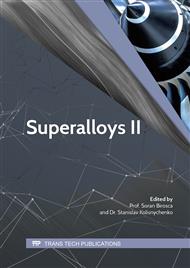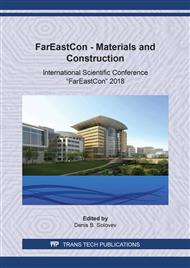[1]
Yu.S. Eliseev, A.G. Boytsov and V.V Krymov, Technology of aviation gas turbine engines production, Mashinostroyeniye. Moscow. (2003).
Google Scholar
[2]
F.I. Demin, N.D. Pronichev and I.L. Shitarev, Technology of gas turbine engines main parts production. SSAU Publishers. Samara. (2010).
Google Scholar
[3]
Yu.S. Eliseev, V.V. Krymov, S.A. Kolesnikov and Yu.N. Vasilyev, Non-metallic composite materials in structural elements and the manufacture of aviation gas turbine engines. Bauman University Publishers. Moscow. (2007).
Google Scholar
[4]
Xu. Huibin and Guo Hongbo, Thermal Barrier Coatings, Woodhead Publishing Limited. Cambridge. (2011).
Google Scholar
[5]
I, Dincer and C. Zamfirescu, Advanced Power Generation Systems. Advanced Power Generation Systems. Oshawa. (2014).
DOI: 10.1016/b978-0-12-383860-5.00006-7
Google Scholar
[6]
A.G. Bratuhin, G.K. Yazov and B.E. Karasev, Modern technology in the production of gas turbine engines. Mashinostroyenie. Moscow. (1997).
Google Scholar
[7]
V.I. Bogdanovich, S.B. Maryin, I.A. Dokukina and M.G. Giorbelidze, Development of coatings composition and equipment for repair and strengthening of power generating unit elements by plasma spraying. Tsvetnye Metally. 5 (2016) 56-62.
DOI: 10.17580/tsm.2016.05.09
Google Scholar
[8]
V.A. Barvinok, Plasma in Technology: Reliability and Resource. Nauka i technologii Publishers. Moscow. (2005).
Google Scholar
[9]
V.I. Bogdanovich and M.G. Giorbelidze, Enhancing thermal barrier coatings performance through reinforcement of ceramic topcoat. IOP Conference Series: Materials Science and Engineering. 156 (2016) 1-7.
DOI: 10.1088/1757-899x/156/1/012016
Google Scholar
[10]
G.V. Bobrov, A.A. Ilin and V.S. Spektor, Theory and technology of inorganic coatings formation. Alfa-М. Мoscow. (2014).
Google Scholar
[11]
V.I. Bogdanovich, M.G. Giorbelidze, Metallographic Study of Mesostructure-Ordered Plasma Ceramic Coatings. Key Engineering Materials. 743 (2017) 118-123.
DOI: 10.4028/www.scientific.net/kem.743.118
Google Scholar
[12]
A.F. Puzryakov, Theoretical bases of plasma spraying technology. Bauman University Publishers. Moscow. (2003).
Google Scholar
[13]
V.I. Bogdanovich and M.G. Giorbelidze, Analysis of the ceramic layer microstructure influence on plasma spray thermal barrier coating performance. IOP Conference Series: Materials Science and Engineering. 286 (2018) 1-7.
DOI: 10.1088/1757-899x/286/1/012008
Google Scholar
[14]
J.J. Skrzypek, A.W. Ganczarski, F. Rustichelli and H. Egner, Advanced Materials and Structures for Extreme Operating Conditions. Springer. Berlin. (2008).
Google Scholar
[15]
V.I. Bogdanovich, M.G. Giorbelidze, Mathematical simulation of surface heating during plasma spraying. IOP Conference Series: Materials Science and Engineering. 177 (2017) 1-7.
DOI: 10.1088/1757-899x/177/1/012057
Google Scholar
[16]
S. Bose, High Temperature Coatings. Elsevier Inc. (2007).
Google Scholar
[17]
B. Robert, Heimann, Plasma spray coating. Wiley. Weinheim. (1996).
Google Scholar
[18]
V.I. Bogdanovich, M.G. Giorbelidze, Mathematical modelling of powder material motion and transportation in high-temperature flow core during plasma coatings application. IOP Conference Series: Materials Science and Engineering. 327 (2018) 1-7.
DOI: 10.1088/1757-899x/327/2/022036
Google Scholar
[19]
G.-H. Meng, B.-Y. Zhang, H. Liu, G.-J. Yang, T. Xu, C.-X. Li, C.-J. Li, Highly oxidation resistant and cost effective MCrAlY bond coats prepared by controlled atmosphere heat treatment. Surface and Coatings Technology. 347 (2018) 54-65.
DOI: 10.1016/j.surfcoat.2018.04.068
Google Scholar
[20]
V.I. Bogdanovich, M.G. Giorbelidze, Model of powder material plastic transformation during plasma coating application. Key Engineering Materials. 685 (2016) 685-689.
DOI: 10.4028/www.scientific.net/kem.685.685
Google Scholar



